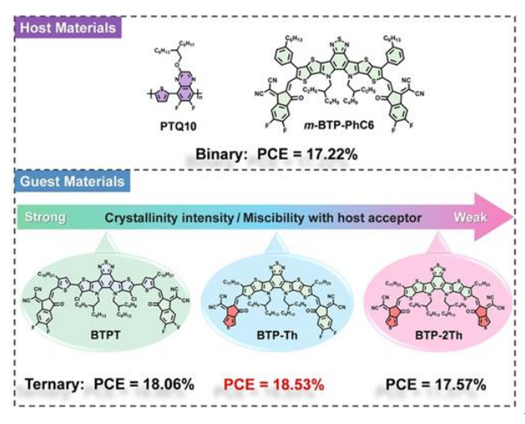Morphology Optimization of the Photoactive Layer through Crystallinity and Miscibility Regulation for High-performance Polymer Solar Cells
Hang Yang 1 , Sunan Bao 1 , Naizhe Cui 1 , Hongyu Fan 1 , Kewei Hu 1 , Chaohua Cui 1,2,*(崔超华) , Yongfang Li 1,2,3
1 Laboratory of Advanced Optoelectronic Materials, Suzhou Key Laboratory of Novel Semiconductor-Optoelectronics Materials and Devices, College of Chemistry Chemical Engineering and Materials Science, Soochow University, Suzhou, 215123, China.
2 Jiangsu Key Laboratory of Advanced Negative Carbon Technologies, Soochow University, Suzhou, 215123, Jiangsu, P. R. China.
3 Beijing National Laboratory for Molecular Sciences, CAS Key Laboratory of Organic Solids, Institute of Chemistry, Chinese Academy of Sciences, Beijing, 100190, China.
Angew. Chem. Int. Ed.2023, 62, e202216338
On the premise of strongly crystalline materials involved, it is a challenge to control the phase separation of bulk-heterojunction donor/acceptor active layer to fabricate high-performance polymer solar cells (PSCs). Herein, we develop a molecular design strategy of the third component to synthesize three guest materials (namely BTPT, BTP-Th, and BTP-2Th) to address this issue. We investigate and reveal the effect of crystallinity and miscibility of the third component in controlling the phase separation of Y6-derivatives-based blend film. As a result, a remarkable power-conversion efficiency of 18.53% is obtained in the ternary PSC based on PTQ10:m-BTP-PhC6 with BTP-Th as the third component, which is a significant improvement with regard to the efficiency of 17.22% for the control binary device. Our study offers a molecular design strategy to develop a third component for building ternary PSCs in terms of crystallinity and miscibility regulation.

链接://onlinelibrary.wiley.com/doi/full/10.1002/anie.202216338